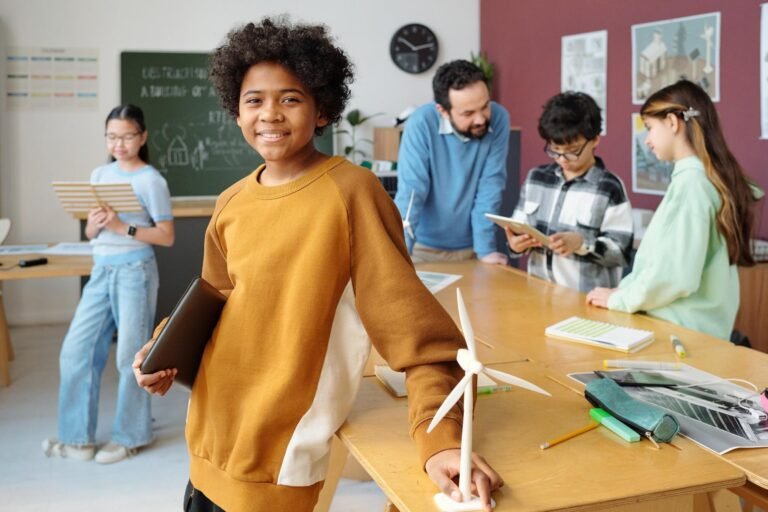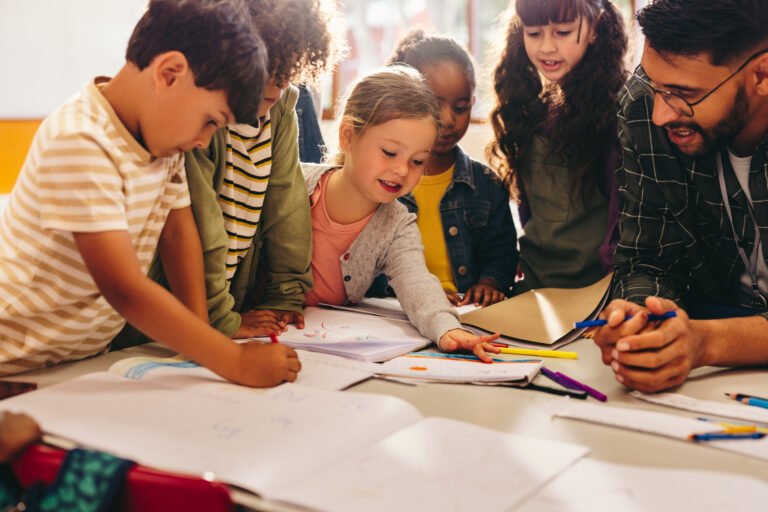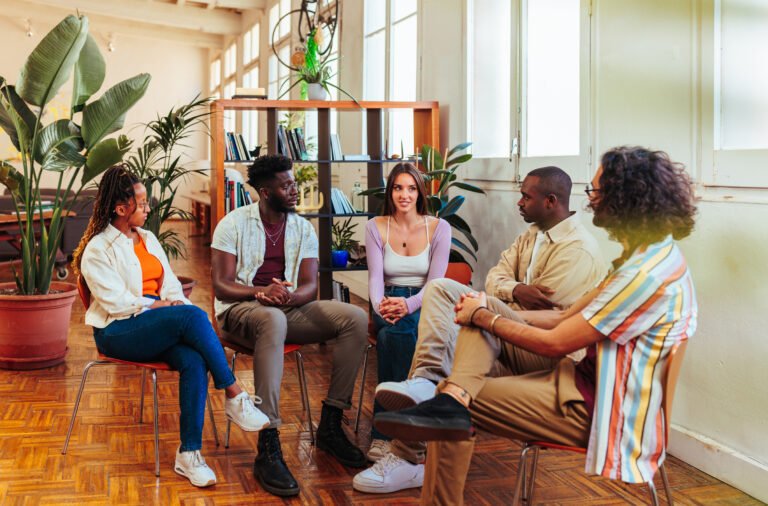
Art therapy for kids uses creative activities to help children express emotions, build confidence, and develop critical thinking skills in a supportive, playful environment that encourages curiosity and personal growth.
Ever wonder how to make art therapy more engaging for children? I think this part is so powerful because helping kids love great art can totally transform their creativity and emotional growth. In my experience, it’s about making art fun, playful, and relatable — not stuffy or boring. This post will walk you through practical tips to unlock your child’s artistic curiosity and create meaningful experiences that stick.
Making great art familiar and accessible to kids
Helping kids connect to great art doesn’t mean they need to be experts or critics—heck, most adults even shy away from it!
Start by bringing art into their world in ways that feel natural and fun. Think of it like inviting a new friend over for playtime rather than a formal meeting. You might say, “Look at this! What do you see?” instead of “Analyze the brush strokes.”
Here’s how to make great art familiar and accessible:
- Use storytelling: Share the story behind the art or artist in simple language. Stories stick better than facts.
- Relate art to kids’ lives: Point out colors, shapes, or scenes they know from everyday experiences.
- Interactive exploration: Encourage them to touch similar textures, create their own versions, or role-play scenes inspired by the artwork.
- Keep visits short and playful: Think of it like a quick snack instead of a long meal. Kids’ attention spans are limited, so quality over quantity.
Research from the National Endowment for the Arts shows that early, positive art experiences can boost creativity by up to 30%. So, making art approachable isn’t just fun—it’s a brain booster too.
Swapping formal art talks for simple curiosity turns looking at art into a game of discovery. It’s like giving your brain a bubble bath—it cleanses stress and fuels imagination with ease.
Ready to see art through your kid’s eyes? Try sneaking in fun questions or games next time you’re near a painting or sculpture. Trust me, it’s way better than forcing them to sit still and stare.
Encouraging children to actively imitate and create art
Want to get kids more into art? Encouraging them to imitate and create is a game-changer. Honestly, copying isn’t cheating here—it’s a learning hug from the greats.
Think of it like learning a dance move: you watch, you mimic, and then you add your own flair. Kids do this naturally when they draw or paint, but we can give them a little nudge.
- Start simple: Pick a colorful painting or sculpture and ask kids to recreate it using crayons, paint, or clay.
- Make it playful: Turn imitating into a fun challenge, like “Can you make a zebra with your own stripes?”
- Encourage personal touches: Remind kids it’s okay to add their own ideas, like changing colors or shapes.
- Use storytelling: Let them imagine stories about their creations to deepen connection and expression.
Studies show that active art-making boosts cognitive skills and emotional intelligence in kids. So, it’s like a double scoop of brain food — fun and growth all in one.
Sometimes, I thought—wait, maybe not everyone knows this—but giving kids permission to imitate takes off the pressure and sparks creativity. It’s like journaling, but with paint and play.
Why not grab some paper and start together? You might find you’re the one who learns the most.
Teaching kids to ask questions and appreciate without judging
Teaching kids to ask questions about art helps them build curiosity—rather than just judging a picture at first glance. Heck, we’ve all been there, right?
Instead of “Do I like this?” try encouraging questions like:
- What do you think is happening here?
- What colors or shapes catch your eye?
- How do you think the artist was feeling?
This simple shift opens up conversations and makes art feel like a mystery to solve, not a test to pass.
Kids learn that there’s no wrong answer when exploring art, which builds confidence and empathy. Honestly, it’s like giving their brains a friendly permission slip to wonder and imagine.
Here are some tips to nurture this:
- Model curiosity by asking your own questions out loud.
- Celebrate all answers, even the silly ones.
- Encourage open-ended discussion, not quick judgments.
Studies show that children who engage in open dialogue about art develop better critical thinking skills and emotional awareness later on. So, isn’t it worth a try?
I thought—wait, maybe this is why some kids become little philosophers. It’s just art talk that sparks big thinking.
Turning art visits into engaging, gamified experiences
Turning art visits into games makes the whole experience way more fun for kids. Honestly, who wants to just stare at paintings without moving?
Here’s a little secret: gamify the visit! It’s like turning a museum into a playground of discovery.
- Create scavenger hunts: Give kids a checklist of colors, shapes, or animals to find in the artworks.
- Use storytelling games: Invite kids to act out or imagine what’s happening in a painting or sculpture.
- Assign art detective roles: Ask questions like “Who do you think made this art?” or “What would a secret message be here?”
- Set fun challenges: “Draw the next scene” or “Make a face like this sculpture” keeps them engaged.
Adding these playful elements can boost kids’ attention and help them absorb more without realizing it. It’s like giving their brain a bubble bath—refreshing and relaxing.
Plus, a study by the Children’s Museum Association found that gamified learning increased kids’ museum engagement by over 40%. So, heck yeah, it works!
I thought—wait, maybe not all museums advertise their hidden playgrounds. You just have to grab the chance and make art visits the best adventure ever.
Wrapping up
Getting kids involved in art therapy isn’t just about making pretty pictures. It’s about sparking curiosity, encouraging creativity, and helping them see art as a fun, safe space for expression.
Remember, it’s okay to let kids explore art in their own way. Asking questions, imitating artists, and turning visits into playful games can make all the difference.
So, the next time you’re near a painting or sculpture, try turning it into a little adventure. Hey, it’s okay to not have all the answers—just join in the fun and watch what happens.
Why not take a moment today to doodle or ask a kid about their favorite art? You both might find a splash of joy in the process.
FAQ — your questions about art therapy answered
What is art therapy and how does it help kids?
Art therapy uses creative activities to help kids express themselves and manage emotions in a safe way.
Can children without art skills still benefit from art therapy?
Absolutely! It’s about self-expression, not being an artist, so all kids can take part and benefit.
How can I make art therapy fun and engaging for my child?
Try gamifying visits to museums or art activities with scavenger hunts and storytelling games to keep things lively.
Is it okay if my child just imitates famous artworks?
Yes, imitating is a natural way to learn and can boost creativity as they add their own personal touches.
Should I encourage my child to ask questions about art?
Definitely. Encouraging curiosity helps kids appreciate art without judgment and improves critical thinking.
Do I need a professional art therapist for my kid to benefit from art therapy?
For casual exploration, you don’t need a pro. But for emotional challenges, a certified therapist can offer tailored support.

A certified Heal Your Life® Coach with 20+ years in education and emotional development. Supports gifted teens in navigating anxiety, perfectionism, and identity challenges, while equipping parents with practical tools for lasting transformation. Sessions blend emotional healing, mindset mastery, and strategic empowerment.



